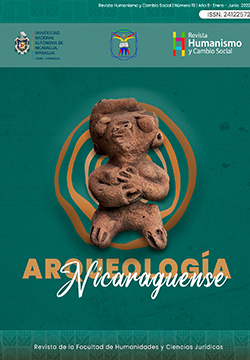Stone tools in Santa María de Nueva Segovia, Nicaragua. 300-800 AD
DOI:
https://doi.org/10.5377/hcs.v19i19.14111Keywords:
Lithic artifacts, archaeology, raw materials, technology, commercial networks, morphotechnical analysis, scrapersAbstract
This research addresses the analysis of lithic archaeological artifacts recovered in the municipality of Santa María de Nueva Segovia, located in the northwest of Nicaraguan territory, bordering the Republic of Honduras. It is based on the fact that these artifacts are the evidence that presents the greatest resistance to inclement weather, therefore, their presence in archaeological contexts will provide important information about their origin, use and development of the technology developed by the society that produced them. Each artifact is the result of various production processes. To approach the knowledge of the effort involved, the raw material, the applied carving techniques and the possible traces of use were analyzed through macroscopic observation and magnifying glass support. With all this one could infer the technological and economic development of the society that produced them. It is important to note that the present study derives from the project entitled “Recognition and Documentation of Archaeological Sites of the municipality of Santa María, Nueva Segovia”, in which eight archaeological sites weredocumented, from which the analyzed lithic sample comes. The project was carried out in the fi rst semester of 2021, under the direction of the Archaeological Center for Documentation and Research CADI of the Faculty of Humanities and Legal Sciences of the National Autonomous University of Nicaragua, UNAN, Managua with the fi nancial and logistical support of the Mayor’s Offi ce of the municipality of Santa María de Nueva Segovia and the collaboration of the Nicaraguan Institute of Culture (INC).
Downloads
486
References
Aoyama, K. (2016). El Poder Político y Económico de Artefactos Líticos de Obsidiana del valle de Copán y la región de La Entrada, Honduras.Revista Ciencias Espaciales, volumen 9, número 2. Pp. 160–180.
Balladares S y Rivera F. Ma. 2011. Inventario Nacional de sitios arqueológicos. Municipios de Jinotega y Matagalpa. Informe Técnico. CADI – UNAN-Managua, Managua.
Braswell, G. (1997). El intercambio comercial entre los pueblos prehispánicos de Mesoamérica y la Gran Nicoya. Revista de la Universidad del Valle de Guatemala. Número 7, noviembre, 1997. Pp. 17-29.
Braswell, G; Salgado, S; Fletcher, L y Glascock, M. (2002). La antigua Nicaragua, la periferia sudeste de Mesoamérica y la región maya: Interacción interregional (1-1522dC). Revista Mayab 15. Pp. 19-39.
Clemente, I; Gassiot, E y Terradas, X. (2008). Manufacture and use of stone tools in the Caribbean Coast of Nicaragua. The analysis of the last phase of the shell midden KH-4 at Karoline (250-350 cal AD). In ‘Prehistoric Technology’ 40 Years Later: Functional Studies and the Russian Legacy, edited by Laura Longo and Natalia N. Skakun, pp. 285–293. BAR International Series. Vol. 1783. Archaeopress, Oxford, England, UK
Espinoza, E. y León, H. (2021). Los grandes centros regionales en el Norte de Nicaragua. En Curiosidades Prehispánicas No. 7. No. 195. Biblioteca Digital Alcaldía de Managua. Managua, Nicaragua. Pp.11-17.
Espinoza, E; Fletcher, L; Salgado, R. (1996) Arqueología de Las segovias: una secuencia preliminar. Instituto Nicaragüense de Cultura, Museo Nacional de Nicaragua. Managua, Nicaragua
Fletcher, L. (1993). Mesoamérica y la Gran Nicoya: Perspectiva desde el Norte de Nicaragua. III encuentro Los Investigadores de la cultura Maya. Adelphi University, New York.
Gutiérrez T, M. (2007). Análisis de industria lítica. Sitio Arqueológico KH-4. Inédito, Tesis de licenciatura. CADI, UNAN-Managua. Managua, Nicaragua.
Laplace, G. (1974). La Typologie analytique et structurales; base rationnelle d´étude des industries lithiques et oeusses. Colloques nationaux N°932. Banques de dones archéologiques. Pp. 91-143.
Lechado R, Leonardo. (2001). Propuesta de una metodología de análisis para el material arqueológico lítico. Caso de estudio, Instituto de Mirafl or. Inédito.Tesis de licenciatura. CADI, UNAN-Managua.
Minami, H; Uemura, M; Balladares, S; Lechado, L. (2016, 2017 2018 y 2019). Proyecto Arqueológico Matiguás. Informes Técnicos Finales. Inéditos. Universidad de Estudios Extranjeros de Kyoto y UNAN-Managua. Managua, Nicaragua.
Semenov, S. A. (1981). Tecnología prehistórica (estudio de las herramientas y objetos antiguos a través de las huellas de uso). Edit. AKAL. Madrid, España.
Downloads
Published
How to Cite
Issue
Section
License
Copyright (c) 2022 Universidad Nacional Autónoma de Nicaragua, UNAN-Managua

This work is licensed under a Creative Commons Attribution-NonCommercial-ShareAlike 4.0 International License.




